
| Glossary of Lepidoptera Technical Terms | (donherbisonevans@yahoo.com) and Stella Crossley |

names of areas of a wing
for example: Acraea andromacha

| Glossary of Lepidoptera Technical Terms | (donherbisonevans@yahoo.com) and Stella Crossley |

names of areas of a wing
for example: Acraea andromacha
abdomen
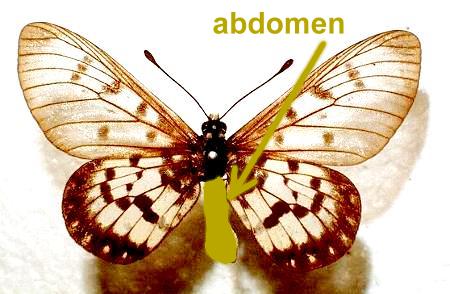
The main tail end of the body, joining onto the
thorax.
anal plate
The tail end of the abdomen, just above the back of the
claspers.
dimorphic
anteromedial
Somewhat nearer the head than halfway across.
apex (plural: apices)
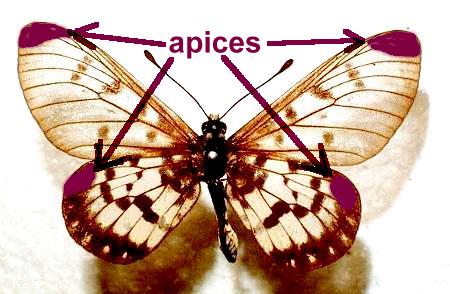
The wing-tip: the area of a wing usually furthest from the body,
where the
costa meets the
termen.
base, basal

The area of a wing nearest the body, where it joins the
thorax.
bipectinate
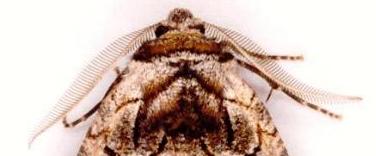
Having two sets of rami, one set each side,
along the length of an antenna.
caudal
Situated in or near the tail or posterior part of the body.
cell
An area near the middle of a wing that is relatively free of veins,
bounded by the radius,
the cubitus
and the discocellular veins.
claspers
The end pair of prolegs
which are often splayed out diagonally backwards.
coremata
Organs at the end of the abdomen of male moths that can be
everted to expose tufts of hair which disperse
pheromones.
costa

The leading edge of a wing, between the
base and the
apex.
cremaster
One or more hooks at the tip of the abdomen of a pupa that hook
into a pad of silk laid on some supporting object.
crochets
Little hooks arranged often in a characteristic pattern under a
proleg.
cubitus
The fifth major vein in a wing in the
Comstock-Needham system.
This refers to species in which the males and females
look substantially different.
discal
Located in a cell near the middle of a wing that is relatively free of veins,
bounded by the radius,
the cubitus
and the discocellular veins.
distal
Located further from the body.
DNA (short for De-oxy-Ribonucleic Acid)
A complex chemical containing the code for producing
a new living individual of its species.
dorsal
Of, or on, the back.
fascia (plural: fasciae or fascias)
A coloured band across a wing, sometimes the colour of which is variable,
but having boundaries with complex shapes which are species-specific.
femur
The section of a leg nearest the body.
frass
The dried pellets of excreta of the caterpillar.
genus (plural : genera)
A genus is a group of
species that appear to be related,
and from their DNA
appear to have evolved from a common ancestor.
 haustellum coiled Niguza spiramioides | 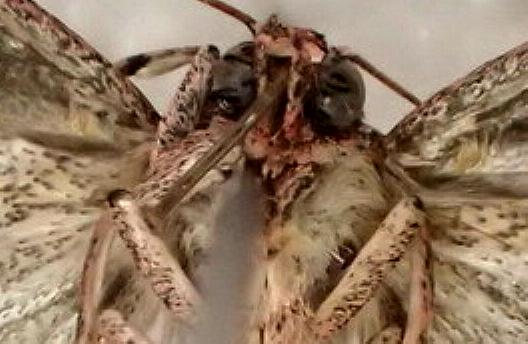 haustellum extended Hypoperigea tonsa |
do not be confused by the |
hind margin
The trailing edge of a wing,
between the tornus
and the base, also called the 'inner margin'.
inner margin

The trailing edge of a wing,
between the tornus
and the base,
also called the 'hind margin'.
These are two structures like short antennae
by the mouth of many invertebrates,
probably used for distinguishing food items.
In some butterflies and moths, they are small
and hardly noticeable, but some species have very
evident palps. In some species they are scaly,
and in some they are hairy.
Some species hold them tucked under the head,
some stiffly out in front of the head,
and others hold them curved up over the head.
Holes along the side of the body, each often surrounded by a ring of colour
in caterpillars. There is one each side of each segment,
and they are are joined together internally to the trachea,
which allows air to flow and diffuse into muscles and organs of the body.
Having three sets of tiny comb-like teeth along the length of
a filament such as an antenna, which is
typical of some
HEPIALIDAE.
Further reading :
Ian F.B. Common,
(updated 19 November 2007, 12 June 2025)
instar
One of the stages of growth in the life of a Caterpillar.
At the end of each stage, having reached the limit of the
elasticity of its skin, it sheds the outer skin layer,
having grown a potentially larger skin underneath.
Often the coloration and/or pattern of the skin
of each instar is different from the previous one.
Most caterpillars go through 5 or 6 instars.
kairomone
A chemical emitted as a smell by one organism that
is detected by another organism which uses it to find the first one.
labial palps
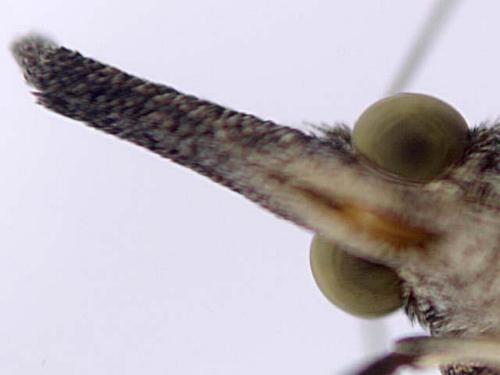
magnified view of the underside of the labial palps
of Hypena subvittalis
(Photo: copyright Lyn Finn,
Hunter Region School of Photography in Newcastle
larva (plural: larvae)
The 'Caterpillar' or second life stage of many insects,
after the egg, and before the pupa.
lateral
referring to a side or both sides of the animal.
margin

An edge of a wing, usually the farthest from the body,
more accurately called the 'outer margin' or 'termen'.
media
The fourth major vein in a wing.
medial
Near or across the middle.
mesothorax
The middle section of the three sections of
the thorax,
carrying the middle pair of legs,
and for adults also the wings of Diptera (Flies), which only have one pair of wings,
and the pair of forewings of adult insects with two pairs of wings.
metathorax
The hind section of the three sections of
the thorax,
carrying the pair of hind legs,
and the pair of hindwings of adult insects with two pairs of wings.
monopectinate
Having one set of tiny comb-like teeth
along the length of a filament such as an antenna.
osmeterium (plural: osmeteria)
A gland bearing strongly smelling substances,
usually forked and everted typically from behind the head.
outer margin

An edge of a wing, usually the farthest from the body,
often called the 'margin' or 'termen'.
parasitoid
A parasitoid is a parasite that damages its host so much that the host dies.
pectinations
The comb-like teeth along the antennae of moths, particularly
evident in male moths, also called rami, sensilla, or ciliations.
pheromone
Specific aromatic substances that attract
the males and females of the same species together.
phyllodes
Flattened stems of some plants which act instead of leaves,
particularly in
pinaculum (plural: pinacula)
A small chitinized
plate on the skin of a caterpillar to which
setae are attached.
postmedial
Between the middle and the margin of a wing.
prothorax
The foremost of the three sections of
the thorax,
carrying the pair of forelegs.
In adult insects, the prothorax does not carry any wings.
pupa (plural: pupae)
The 'chrysalis' or third stage in
the life of many insects (between the
larva and adult stages),
often surrounded by a silk cocoon,
and in which the major metamorphosis from larva to adult occurs.
radius
The third major vein in a wing in the
Comstock-Needham system.
rami
The comb-like teeth along the antennae of moths, particularly
evident in male moths, also called pectinations, or ciliations, or sensilla.
reniform
rubicundalis
A kidney-shaped mark or area.
scape
The part of an antenna nearest the head.
sclerotized
Stiffened by being partially composed of
chitin.
scoli
Wart-like knobs on a caterpillar which each have one bristle.
seta (plural: setae)
A stiff hair or bristle made of
chitin.
The setae of caterpillars can have simple pointed tips,
but are often elaborate,
including setae with spiculate margins,
setae with blunt, inflated, capitate, spatulate, or forked tips,
or flattened ovate to discoid setae,
as well as inflated, or hollow, open-tipped setae which
often exude a viscous, sticky fluid
that accumulates as a droplet at the end of the seta.
species
A species is a group of living entities,
(such as animal, plant, bacteria etc) which when opposite sexes mate,
their progeny are fertile, and when they mature: they can also mate,
and produce more of that type of entity, and so on.
spiracles
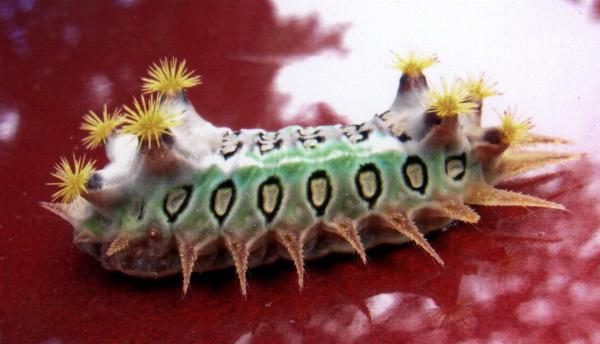
(Photo: courtesy of Albert Goede, Hobart)
Caterpillar of Doratifera oxleyi
showing the prominent spiracles, each ringed in yellow and black.
subcostal
Somewhat inward from
costa,
the leading edge of the wing.
submarginal/subterminal
Somewhat inward from the edge of the margin (outer margin or
termen).
synanthropic
Found in the company of humans.
synonym
A scientific name given to a biological entity
such as a species or family, by an author
describing it in a scientific publication,
usually after it has already been described and given
another name.
tarsus (plural: tarsi)
A foot, attached to a
tibia at the end of a leg.
termen

The edge of a wing furthest from the body,
between the apex and the
tornus,
also called the 'outer margin' or just 'margin'.
thorax
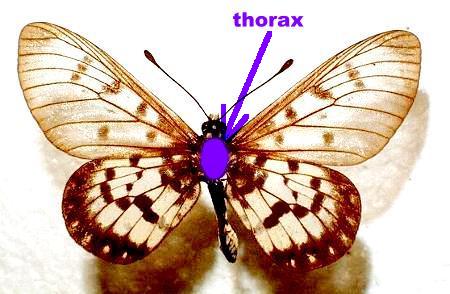
One of the three sections of the body of an insect,
between the head and the abdomen.
The thorax holds the six legs, and also the wings, if any.
The thorax itself is divided into three sections,
each holding one pair of legs:
the prothorax,
the mesothorax, and
the metathorax.
tibia
The second section of a leg, between the
femur
and the
tarsus.
tornus
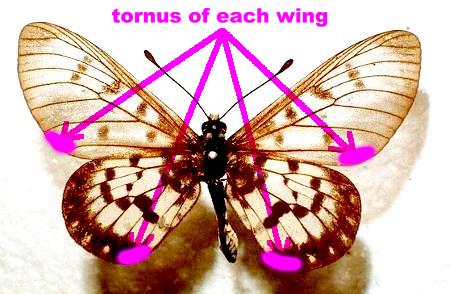
The rear corner of a wing, where the
outer margin meets the
inner margin.
tripectinate
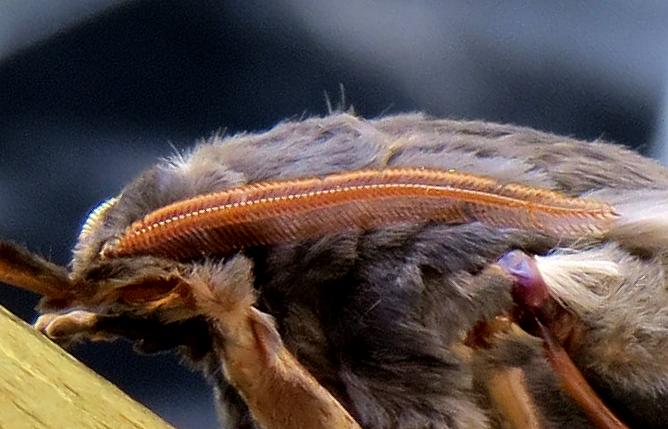
head, showing tripectinate antennae
of Abantiades atripalpis
(Photo: courtesy of Robin Sharp, Victoria)
unipectinate
Having one set of tiny comb-like teeth
along the length of a filament such as an antenna.
ventral
Underneath, on the underside.
verrucae
Pale wart-like knobs on a caterpillar to which a number
of setae are attached.
Moths of Australia,
Melbourne University Press, 1990, pp. 5-28, and 512-517.

flowers

butterflies
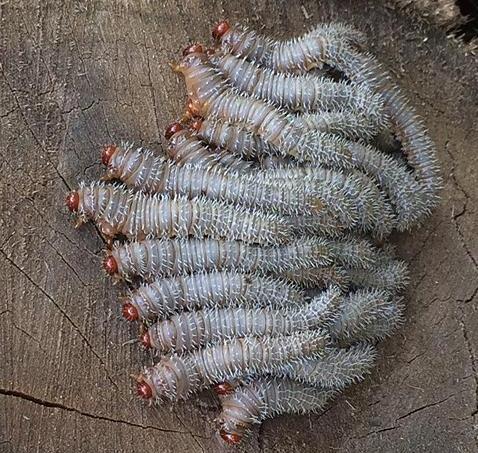
FAQS

Lepidoptera

moths

FAQS